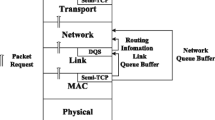Abstract
The huge commercial success of mobile telephony, the phenomenal growth of Internet users, the popularity of IP-based multimedia applications are the major driving forces behind third-generation (3G), ongoing Byond 3G (B3G), and forth-genertion (4G) evolution. 3G brought wired applications, both data and multimedia, into wireless environments. It operates on IP-based infrastructures to provide wider service access capability. To support and satisfy QoS (Quality of Service) of diverse IP-based multimedia applications, traffic management, such as Connection Admission Control (CAC) and resource allocation, becomes essential. CAC and resource allocation are computationally complex when combined with QoS guarantee for traffic with different characteristics. However, CAC and resource allocation are real-time traffic control procedures. Hence, processing load should be minimized to reduce delay. At the same time, network resources should be utilized efficiently to accommodate more users. However, reducing processing load and obtaining high resource utilization efficiency has been considered to be contradictory matter. In addition, CAC and resource allocation schemes which consider multiple QoS criteria – loss and delay – simultaneously have not been adequately studied. Simultaneous QoS consideration is important to satisfy stringent and diverse QoS requirements of multimedia traffic. In this paper, we propose a nobel effective bandwidth/buffer calculation method based on a virtual channel/buffer analysis scheme. We show that our method can achieve high resource utilization efficiency with reduced processing load. Moreover, we show that our scheme allows for simultaneous consideration of multiple QoS criteria, loss and delay.
Similar content being viewed by others
References
K. Belkacem and S. Mischa, Bandwidth allocation strategies in wide-band integrated networks, IEEE Journal on Selected Areas in Communications 4(9) (1986) 869–878.
A.W. Berger and W. Whitt, Effective bandwidth with priorities, IEEE/ACM Transactions on Networking 6(4) (1998) 447–460.
C.S. Chang and J.A. Thomas, Effective bandwidth in high-speed digital networks, IEEE Journal on Selected Areas in Communications 13(9) (1995) 1091–1100.
G.L. Choudhury, D.M. Lucantoni and W. Whitt, Squeezing the most out of ATM, IEEE Transactions on Communications 44 (1996) 203–217.
A.I. Elwalid and D. Mitra, Effective bandwidth of general Markovian traffic sources and admission control of high speed networks, IEEE/ACM Transactions on Networking 1(3) (1993) 329–343.
A.I. Elwalid, D. Mitra and R.H. Wentworth, A new approach for allocating buffers and bandwidth to heterogeneous, regulated traffic in an ATM node, IEEE Transactions on Selected Areas in Communications (August 1995) 1115–1127.
R.J. Gibbens and P.J. Hung, Effective bandwidth for the multi-type UAS channel, Queueing Systems 9 (1991) 17–28.
R. Guerin, H. Ahmadi and M. Naghshineh, Equivalent capacity and its application to bandwidth allocation in high-speed networks, IEEE Journal on Selected Areas in Communications 9(7) (1991) 968–981.
G.P. Harry and M.E. Khaled, Call admission control schemes: A review, IEEE Communication Magazine (November 1996) 82–91.
J.Y. Hui, Resource allocation for broadband networks, IEEE Journal on Selected Areas in Communications 6(9) (1988) 1598–1698.
F.P. Kelly, Effective bandwidths at multi-type queues, Queueing Systems 9 (1991) 5–15.
F.P. Kelly, Note on effective bandwidths, in: Stochastic Networks (Clarendon Press, Oxford, UK, 1996) pp. 141–168.
G. Kesidis, J. Walrand and C.S. Chang, Effective bandwidths for multiclass markov fluids and other ATM sources, IEEE/ACM Transactions on Networking 1(4) (1993) 424–428.
P. Lin, B. Benssou, Q.L. Ding and K.C. Chua, CS-WFQ: A wireless fair scheduling algorithm for error-prone wireless channels, in: Proc. of IEEE Internat. Conf. on Comput. Commun. & Networks, Las Vegas, NV (October 2000).
K. Shiomoto, N. Tamanaka and T. Takahashi, Overivew of measurement-based connection admission control methods in ATM networks, IEEE Communications Surveys (first quarter 1999).
G. Veciana, G. Kesidis and J. Walrand, Resource management in wide-area ATM networks using effective bandwidth, IEEE Journal on Selected Areas in Communications 13(9) (1995) 1081–1090.
W. Whitt, Tail probabilities with statistical multiplexing and effective bandwidths in multi-class queue, Telecommunication Systems 2 (1993) 71–107.
Author information
Authors and Affiliations
Corresponding author
Rights and permissions
About this article
Cite this article
Kim, Y. QoS Provisioning with New Effective Bandwidth/Buffer Calculation Scheme in Wireless IP Networks. Telecommun Syst 28, 169–184 (2005). https://doi.org/10.1007/s11235-004-5015-z
Issue Date:
DOI: https://doi.org/10.1007/s11235-004-5015-z




